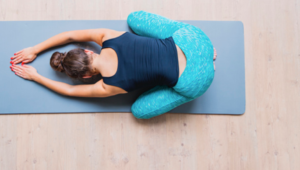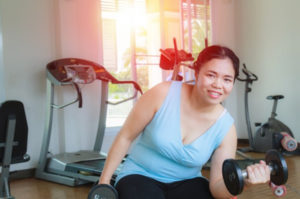Our Relationship with Physical Activity

Research Corner: Understanding Our Members’ Relationship with Physical Activity
What supports people with Axial Spondyloarthritis to do physical activity?
What hinders them?
Lauren Angelil (physiotherapist, health coach and vice-chairperson of Axial Spondyloarthritis Association South Africa, pictured left) is asking these questions.
She’s doing her masters in Physiotherapy with a specialisation in Behavioural Medicine. She’s interested in the psychology of putting health information into practice.
The axSpA challenge we’re seeing
When diagnosed with axSpA, the gold standard to manage the condition is medication, physical activity, and education.
But few patients with axSpA meet the general exercise recommendations (Haglund
et al., 2012 1 ), and few perform vigorous aerobic physical activity ( 2 Fongen, et al.,
2013).
The question is – what happens with physical activity?
The unique benefits of physical activity in axSpA
The benefits of physical activity on health and wellbeing in axSpA are significant. It is one of the cornerstones of disease management. The reasons are as follows:
● It positively impacts pain experience, spinal mobility, physical function,
and cardiovascular health
● High intensity exercise is well tolerated and associated with reduced
axSpA disease activity
But, there is a mismatch between the recommendation and the action.

The additional axSpA challenge
Getting started and keeping up with these physical activity guidelines is a challenge.
What’s more, following an exercise plan without axSpA is known to be hard. Having a disease affecting your physical and mental health makes it even more difficult.
But, following all the axSpA treatment recommendations can make a huge difference! It’s possible to achieve much lower levels of disease activity or have low levels of disease activity. The question remains – what happens with physical activity?
Where to from here
We have limited research available to understand what supports or hinders physical activity. What’s more, barriers and facilitators are not only related to disease symptoms. They include psychological state, and environmental and
social support, or the lack thereof.
The research will help us understand the gap between exercise recommendations and action.
What we can all do
I encourage everyone reading this to spark conversations about physical activity in their patient groups.
The World Health Organization (WHO) recommends:
● At least 150-300 minutes of moderate intensity physical activity or 75-150 minutes of vigorous intensity physical activity exercise per week or a combination and
● Two strength training sessions a week

Find out from your members:
1. What do they enjoy about exercise?
2. What are the challenges?
3. Who or what supports them in their exercise?
Encourage members to post about their experiences and hold each other compassionately accountable to their goals.
Exercise can be really challenging – it takes time, effort and it can be uncomfortable. Sparking conversations with an air of curiosity and compassion can go a long way.
If you’re interested in hearing more about the research or sparking conversations, reach out to Lauren at healthcoach@laurenkimwellness.com or find her and the South African Axial Spondyloarthritis Association team on
Facebook.
1 Haglund E, Bergman S, Petersson IF, Jacobsson LT, Strombeck B, Bremander A., Differences in physical activity patterns in patients with spondylarthritis, Arthritis Care Res (Hoboken). 2012;64:1886–1894.
2 Fongen C, Halvorsen S, Dagfinrud H., High disease activity is related to low levels of physical activity in patients with ankylosing spondylitis, Clin Rheumatol. 2013;32:1719–1725.
Other NEWS

Webinar: HCP Education
Monday 19 May at 14:00-15:00 BST Register Now The global delay to …
Read More
The Pursuit of Remission and Improved Quality of Life in axSpA
Join the Global Alliance for Patient Access (GAfPA) and ASIF’s …
Read More
